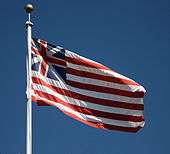Grand Union Flag
 | |
| Names | The Grand Union Flag, Continental Colors; Congress Flag; Cambridge Flag; First Navy Ensign |
|---|---|
| Adopted | December 3, 1775 |
| Design | Thirteen horizontal stripes alternating red and white; in the canton, the British Union Flag |
The "Grand Union Flag" (also known as the "Continental Colors", the "Congress Flag", the "Cambridge Flag", and the "First Navy Ensign") is considered to be the first national flag of the United States of America,[1] previously that of the United Colonies of North America, until 1777.
This flag consisted of 13 alternating red and white stripes (like the current Flag of the United States), but with the upper inner corner or canton being the British Union Flag of the time (prior to the inclusion of St. Patrick's cross for the 1801 unification of Ireland with Great Britain).
History


By the end of 1775, during the first year of the American Revolutionary War, the Second Continental Congress operated as a de facto war government authorizing the creation of an Army, a Navy and even a Marine Corps. A new flag was required to represent the Congress and fledgling nation, initially the United Colonies, with a banner distinct from the British Red Ensign flown from civilian and merchant vessels, the White Ensign of the King's Royal Navy, and the British Union flags carried by the King's army troops on land.
The American colonist's (Continental Colour) was first hoisted on the colonial warship Alfred, in the harbor on the western shore of the Delaware River at Philadelphia, Pennsylvania on December 3, 1775, by newly-appointed Lieutenant John Paul Jones of the formative Continental Navy. The event had been documented in letters to Congress and eyewitness accounts.[2] The flag was used by the American Continental Army forces as both a naval ensign and garrison flag throughout 1776 and early 1777.
It is not known for certain when or by whom the design of the Continental Colors was created, but the flag could easily be produced by sewing white stripes onto the British Red Ensigns.[3] The "Alfred" flag has been credited to Margaret Manny.[4]
It was widely believed that the flag was raised by George Washington's Army on New Year's Day, 1776, at Prospect Hill in Charlestown (now part of Somerville), near his headquarters at Cambridge, Massachusetts, (across the Charles River to the north from Boston), which was then surrounding and laying siege to the British forces then occupying the city, and that the flag was interpreted by British military observers in the city under commanding General Thomas Gage, (1719-1787), as a sign of surrender.[5] Some scholars dispute the traditional account and conclude that the flag raised at Prospect Hill was probably a British union flag.[3]
The name "Grand Union" is contemporary to Reconstruction-era historians and was first applied to the Continental Colors by George Henry Preble, in his 1872 History of the American Flag.[3]
The design of the flag is strikingly similar to the flag of the British East India Company (EIC). Indeed, certain EIC designs in use since 1707 (when the canton was changed from the flag of England to that of the Kingdom of Great Britain) were nearly identical, but the number of stripes varied from 9 to 15. That EIC flags could be well known by the American colonists has been the basis of a theory of the origin of the national flag's design.[6]
The Flag Act of 1777 by the Continental Congress authorized a new official national flag of a design similar to that of the Colors, with thirteen stars (representing the thirteen States) on a field of blue replacing the British Union Flag in the canton. The resolution describes only "a new constellation" for the arrangement of the white stars in the blue canton so a number of designs were later interpreted and made with a circle of equal stars, another circle with one star in the center, and various designs of even or alternate horizontal rows of stars, even the "Bennington flag" from Bennington, Vermont which had the number "76" surmounted by an arch of 13 stars, later also becoming known in 1976 as the "Bicentennial Flag". The combined crosses in the British Union flag symbolized the union of the Kingdom of England and the Kingdom of Scotland. The symbolism of a union of equal parts was retained in the new American flag, as described in the Flag Resolution of June 14, 1777 (later celebrated in American culture and history as "Flag Day").
See also
References
- ↑ "History", Our Flag, Federal Citizen Information Center
- ↑ Letters of delegates to Congress, 1774–1789, 2, September–December 1775, Virginia,
- 1 2 3 Ansoff 2006.
- ↑ Leepson 2004, p. 51.
- ↑ Preble 1880, p. 218.
- ↑ Fawcett 1937.
Bibliography
- Ansoff, Peter (2006), "The Flag on Prospect Hill", Raven: A Journal of Vexillology, 13: 77–100, ISSN 1071-0043, LCCN 94642220.
- Fawcett, Charles (October 1937), "The Striped Flag of the East India Company, and its Connexion with the American 'Stars and Stripes'", Mariners Mirror.
- Hamilton, Schuyler. (1853). History of the National Flag of the United States of America
- Leepson, Marc (2004), Flag: An American Biography, ISBN 0-312-32308-5.
- Preble, George Henry (1880), History of the Flag of the United States of America.